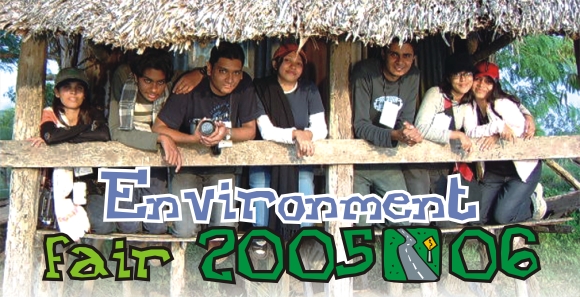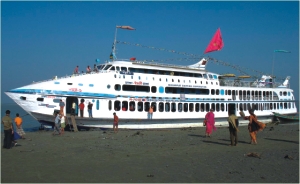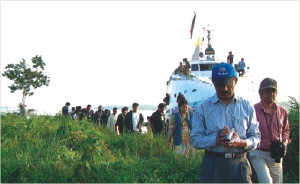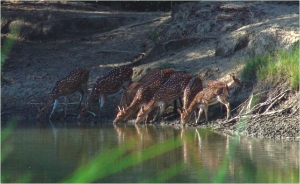
By Risalat Khan
The Young Explorers' Society had long been planning a five-day trip to the Sundarbans, so when we finally set off on December 29, 2005, we were bursting with excitement. We started from Shadarghat at 6:30 pm, two hours behind schedule, and boarded the Mayur-1, resplendent with her 14 cabins.
We had a few special guests with us on the ship. Among them were Abdullah Abu Syed, who needs no introduction, Dr. A. R. Khan, bird-specialist, Ronald Haldar, artist Syed Enayet Hossain and Anwarul Haque who painted some lovely pictures along the trip. At different times throughout the trip, open discussions were arranged where people could interchange ideas.
Next day, after having braved the cold and unfavourable bedding conditions, we reached  Bogi close to noon. We had a Baul group with us who entertained us after breakfast with some famous Baul songs and a few of their own compositions. We did not see any wildlife at Bogi, but there were shady trees and pleasant vistas that invited a photo session.
Bogi close to noon. We had a Baul group with us who entertained us after breakfast with some famous Baul songs and a few of their own compositions. We did not see any wildlife at Bogi, but there were shady trees and pleasant vistas that invited a photo session.
After half an hour or so, we started for Shoronkhola, which we reached a couple of hours later. This place was quite similar to Bogi. We stayed for about an hour. Many people went quite far from where they started. When everybody returned to the vessel it was almost evening. Again we were on our way. This time, our destination was Kotka.
We reached Kotka at around 7 in the morning. Our ship was anchored near the famous Jamtala Watch Tower, which provided a very nice view of the forest nearby. Beyond the tower was an approximately 4-5-kilometer trail to the Kotka sea-beach. The trail had the dense forest on one side and grassland on the other. The place was perfect for a Royal Bengal Tiger to lurk in. Easily noticeable footprints of the king of the Sundarbans were found dried in the mud nearby.
The beach was an awesome place. The sun was still low on the blue, crystal clear horizon. It was tough to resist the temptation of bathing in the sea, but we had Dublar Chor to get to, so we rounded up the group and set off.
We reached Dublar Chor with a few hours of daylight still left. Many people were flying kites of different sizes, shapes and colours. Some were building the model of a Sun with bamboos and cloth that would represent the New Year's first sunrise at the dawn of 1st January, 2006. Some were building structures with sand. The tiger and deer were nicely built.
bamboos and cloth that would represent the New Year's first sunrise at the dawn of 1st January, 2006. Some were building structures with sand. The tiger and deer were nicely built.
Some people were watching the Baul group perform very enthusiastically. Almost all the people had come down from the ship to explore the place and have some fun. However, it wasn't very safe to wander around after evening, so the people had to be sent back on board.
After snacks, some of the participants caught a movie on the projector, while the volunteers prepared the floating lamps or mongol prodeeps.
Just before midnight, the mongol prodeeps were lit and handed over to the eager participants. As the clock struck 12, the lanterns were carefully placed one by one on the surface of the water for them to be carried away by the waves. The sight of different coloured lanterns floating away was one to remember. Many people were more eager to look at the clear, starry sky through a powerful telescope that we had with us.
We ushered in the New Year the next morning by raising the 40 foot long replica of the sun to commemorate the first sunrise (although we missed the actual sunrise by a couple of hours).
On the first day of 2006 we started towards Bogi from Dublar Chor to return to Dhaka, but as we ran out of water we anchored again at Kotka (this time a different side of it) where we had the opportunity to see a group of deer drinking water from a pond. We also saw various kinds of birds.
We were anchored here for quite some time and everyone explored the area pretty well. While returning from Kotka we decided to take a shortcut as we had fallen badly behind schedule. We went through a canal and got stuck because of low tide and were further delayed for almost 6 hours.
The experience was quite thrilling. Some of us also got to see a huge crocodile submerge in the water. We were on the move again during high tide. Next we reached Kaukhali (near Potuakhali) at noon; almost everyone got down and had the chance to spend some money on the local market. It was quite a good start to the New Year for the local vendors.  Many went to a sweet shop named “Nishikundu” which was pretty popular in that area (the sweets tasted awesome).
Many went to a sweet shop named “Nishikundu” which was pretty popular in that area (the sweets tasted awesome).
When everyone was back in the ship a chart paper was taken around the ship for all the participants to sign and write their comments. Our last stop was Chandpur where we stayed only for 15 minutes. No one got down since it was evening and many activities were taking place onboard, such as briefing from bird-specialist Ronald Halder, quiz competition for the interested participants and art competition for the kids.
In this gathering the participants also got to express their feelings about the arrangements of the trip.
Finally we reached Shadarghat at 1:30 am on 3rd January, 06. That night many participants stayed onboard of Mayur-1 due to lack of transportation at night.It was tough saying goodbye to all the new friends we had made.
YES, thanks all the enthusiastic participants and guests who went with us, especially Annie for entertaining us with her beautiful voice, Sanjay bhai for making the model of the Sun and for singing his beautiful songs to us, and those who went as participants but worked with us as volunteers.
